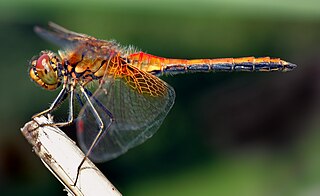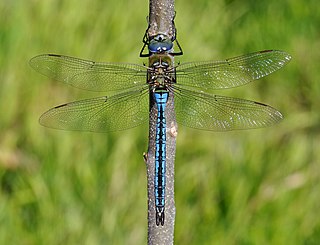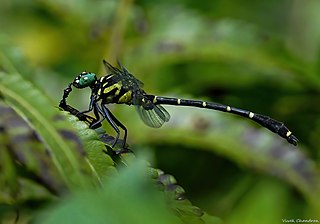Related Research Articles

Odonata is an order of flying insects that includes the dragonflies and damselflies. Members of the group first appeared during the Triassic, though members of their total group, Odonatoptera, first appeared in Late Carboniferous.

A dragonfly is a flying insect belonging to the infraorder Anisoptera below the order Odonata. About 3,000 extant species of true dragonfly are known. Most are tropical, with fewer species in temperate regions. Loss of wetland habitat threatens dragonfly populations around the world. Adult dragonflies are characterized by a pair of large, multifaceted compound eyes, two pairs of strong, transparent wings, sometimes with coloured patches, and an elongated body. Many dragonflies have brilliant iridescent or metallic colours produced by structural colouration, making them conspicuous in flight. An adult dragonfly's compound eyes have nearly 24,000 ommatidia each.
The British Dragonfly Society is a conservation organisation in the United Kingdom. It was founded in 1983 and its aims are to promote and to encourage the study and conservation of dragonflies and damselflies and their natural habitats, especially in the United Kingdom.

Aeshna isoceles is a small hawker dragonfly that is found in Europe, mostly around the Mediterranean, and the lowlands of North Africa. Its common name in English is green-eyed hawker. In Britain it is a rare and local species and is known as the Norfolk hawker. It has a brown colour with green eyes and clear wings and also a yellow triangular mark on the second abdominal segment which gave rise to its scientific name. It used to be in the genus Anaciaeschna as it has several differences from the other members of the genus Aeshna. Its specific name is often spelt isosceles.

Cynthia Evelyn Longfield was an Anglo-Irish entomologist and explorer and the first woman member of the Entomological Society. She was an expert on the dragonfly and an explorer. She was called "Madame Dragonfly" for her extensive work. She was passionately fond of dragonflies and her dominant area of interest was natural history. She travelled extensively and published The Dragonflies of the British Isles in 1937. She worked as a research associate at the Natural History Museum, London. Longfield was the expert on the dragonflies at the museum, researching particularly African species.

The emperor dragonfly or blue emperor is a large species of hawker dragonfly of the family Aeshnidae, averaging 78 millimetres (3.1 in) in length. The generic name Anax is from the ancient Greek ἄναξ, "lord"; the specific epithet imperator is the Latin for "emperor", from imperare, to command.
The Journal of the British Dragonfly Society is a scientific journal published twice-yearly by the British Dragonfly Society since 1983. It contains material relevant to Odonata recorded from the United Kingdom. The editor-in-chief is P. J. Mill.

Somatochlora, or the striped emeralds, is a genus of dragonflies in the family Corduliidae with 42 described species found across the Northern Hemisphere.

Elliot Charles Gordon Pinhey was an entomologist who worked in Africa and specialised in African Lepidoptera and Odonata. Born of British parents on holiday in Belgium, Pinhey made major contributions in entomology to the knowledge of butterflies, moths and dragonflies. Elliot Pinhey's interest in natural history first developed during his early education in England.

Anax ephippiger, the vagrant emperor, is a species of dragonfly in the family Aeshnidae. It migrates to Afro-tropical, Europe, central and southern Asia through monsoon winds.

Leucorrhinia is a genus of dragonfly in the family Libellulidae. They are commonly called whitefaces because of their distinctive pale frons.
For others uses see Frederick Fraser (disambiguation)

Chalcolestes viridis, formerly Lestes viridis, is a damselfly of the family Lestidae. It has a metallic green body and at rest it holds its wings away from its body. Its common name is the willow emerald damselfly, the green emerald damselfly, or the western willow spreadwing. It has an elongated abdomen and pale brown spots on its wings and resides in areas of still water with overhanging trees.

The brilliant emerald, Somatochlora metallica, is a middle-sized species of dragonfly. It is the largest and greenest of the Somatochlora species; 50–55 millimetres (2.0–2.2 in) long.

The genus Epiophlebia is the sole member of the family Epiophlebiidae, which is itself the sole living representative of the Epiproctan infraorder Epiophlebioptera, and it contains only three species. The first two species were historically placed in their own suborder Anisozygoptera, considered intermediate between dragonflies and damselflies, mainly because the hind wings are very similar in size and shape to the forewings and held back over the body at rest, as in damselflies. It has more recently been recognized that the genus Epiophlebia shares a more recent ancestor with dragonflies, and the group has accordingly been reclassified as an infraorder within the dragonflies. Very recently a third species, Epiophlebia sinensis, has been described from Heilongjiang province in northeast China, bridging Epiophlebia distribution gap between Nepal and Japan. A fourth species has been claimed from larval material from South China, but this is not universally accepted. Epiophlebia species are a freshwater indicator of a river ecosystem health. A study that has been conducted on the head anatomy of Epiophlebia has verified the presence of 41 muscles in the head of the larva. Like in true dragonflies (Anisoptera) the aquatic nymphs breathe through a rectal chamber, but jet propulsion has yet to be documented. Epiophlebia species are a representative of a dragonfly fauna which originated during the Jurassic period on the rising continent of Eurasia.

Burmagomphus cauvericus is a species of dragonfly in the family Gomphidae. It was earlier known only from the banks of Kaveri river in Kodagu district. It is recently recorded from Kerala too.
References
- ↑ "Odonata Rarities Committee". British Dragonfly Society. Retrieved 10 April 2017.